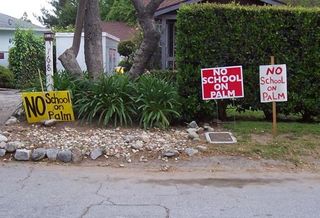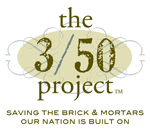(Editor's note: We're very pleased to welcome Altadena community journalist Laura Berthold Monteros as one of our correspondents.)
by Laura Berthold Monteros
For Altadenablog

The property on the north side of a quiet stretch of East Palm is a rustic compound that has historically been home to a YMCA camp and Bienvenidos, an unobtrusive residential facility for young children. The property on the south side is lined with well-kept single-family homes. The north side is currently in escrow to The Almansor Center, which wants to adapt it for use as an educational center for autistic children. The south side displays red and yellow signs that shout, “No School on Palm”.
As opposed as the two viewpoints are, both seem to be trying to respectfully address their differences. A statement from the Palm Street Area Residents Association (PSARA) reads, in part, “We appreciate their meeting with us during their ‘due diligence’ phase….” Further down, PSARA compliments the work of the center with at-risk youth and children with autism.

For her part, Nancy Lavelle, founder and president of Almansor Center in South Pasadena, wants to bring residents in on the process and to ensure their concerns are addressed. “We are still studying various concerns the neighbors have brought forward,” she said in an interview on Monday. “We welcome continued dialogue with the neighbors.”
But the differences are real and intractable.
Neighbors say they are still reeling from the traffic, pollution, and noise problems they claim Sahag Mesrob Armenian Christian School created when it opened in Sept. 2008 with 250 lower-grade students, and without proper county permits. Residents say the only notice they received was a flier in the mailbox that spring. After a court battle, the school was closed down by the county in June, 2009.
Almansor Center insists it would be a different kind of neighbor. “Most of the neighbors moved in or were already there when the site was used for children,” said Lavelle, adding that the facility was used for Head Start at one point as well as for other children’s programs. “Bienvenidos was responsive to them. In the South Pasadena neighborhood, we are used to building relationships with neighbors. We can be that kind of neighbor that people think is a good neighbor, keeping the property in tip top condition.”
Coleen Sterritt, a 12-year resident who with a neighbor organized opposition to Sahag Mesrob, writes, “It didn’t help that those associated with Sahag Mesrob were arrogant and rude in their dealings with the residents, but that attitude was not the real problem. The real problem was a school, period. A school is not appropriate for this site.
“Except for Sahag Mesrob Armenian Christian School, which operated without proper permits, there has never been a day school operated on this property,” she adds. “Almansor is telling PSARA that there will be no impact to the neighborhood, but our actual experience with Sahag Mesrob has demonstrated otherwise.”
With its South Pasadena facility filling up, Almansor plans to accommodate the autistic children by adding to the school population gradually. Starting with 50 children, 50 more per year would be added until attendance is up to 250. All the children would arrive in vans that hold nine, rather than in single-family cars. Arrival times would be staggered, release times varied, and drivers trained to yield to residents pulling out of their driveways or wanting to pass.
“We’re doing a traffic study,” consultant Carolyn Seitz said. “Engineers are looking at the roadway, traffic circulation, where to drop off children. There will be no access on Raymond Avenue. They will design a traffic pattern that reduces the impact on the neighborhood.”
The neighborhood association, in its statement, counters, “The combination of noise, traffic, and pollution resulting from staff, 250 children, cars, vans, etc. would most definitely violate nuisance standards. Further declining property values as a result of a school using this site would be injurious to all homeowners, violating the General Welfare Standard of the Conditional Use Permit.”
Lavelle does not believe that Almansor will reduce property values. “Schools are located in neighborhoods—if a school is responsive and takes care of the property, values won’t go down,” she stated.
Lavelle acknowledges that Almansor may be required to do other studies prior to escrow closing, and Seitz mentioned the noise factor. “The property is like a bowl—low in the middle—so we’re looking at acoustics, how to do an acoustical analysis when no one’s on the property. It’s hard to tell how sound will travel.”
Though the center will accommodate grades K-12, Lavelle does not expect the noise level to be as high as in a regular school. “There will only be 36 children on the playground at one time. They are developmentally not like a typical middle school or high school child. They can’t tolerate noise or confusion.
“We’re having to overcome a couple of things: the neighborhood had a terrible experience in the past, and having the neighbors feel like these kinds of solutions will work. We’re digging out of a hole.”
The residents association statement concludes, “We support the great work of The Almansor Center as it addresses the needs of at-risk youth and young adults as well as children with autism, but we unanimously agree that a school of any kind will not work in our neighborhood.”
NOTE: Palm Street Area Residents Association covers the following area: Palm St. from Fair Oaks to Marengo and the streets feeding off Palm (Almond Alley, Ewing, Highview, Raymond north and south of Palm), Pentagon off Raymond, Emerson north of Palm, and Poppyfields cul-de-sac off Emerson.



